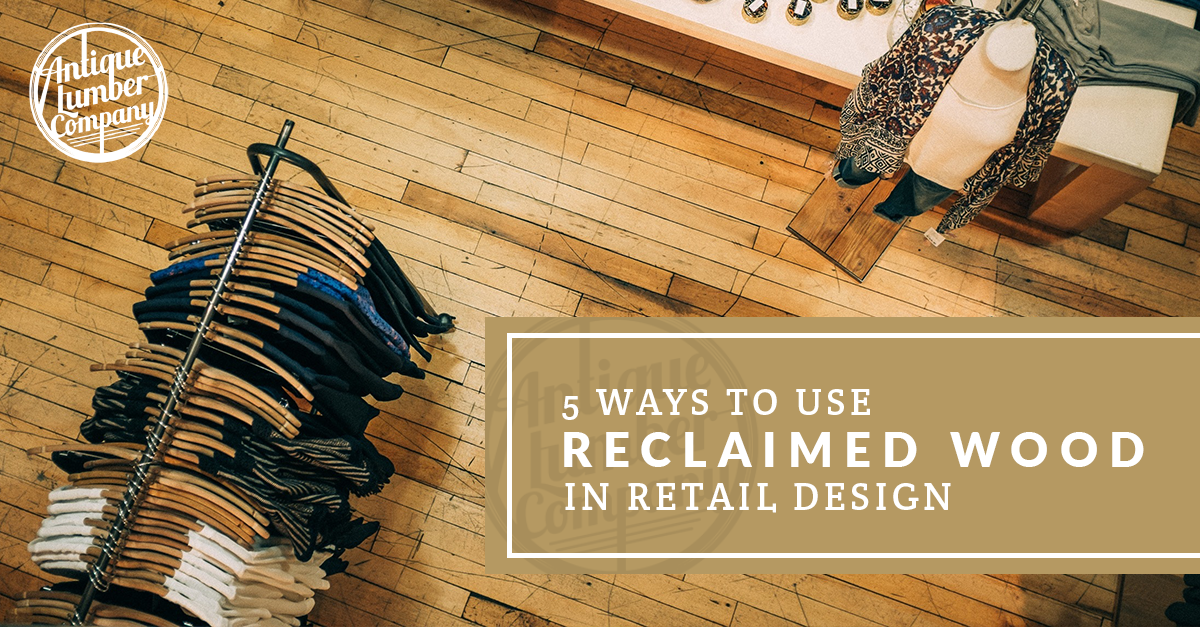
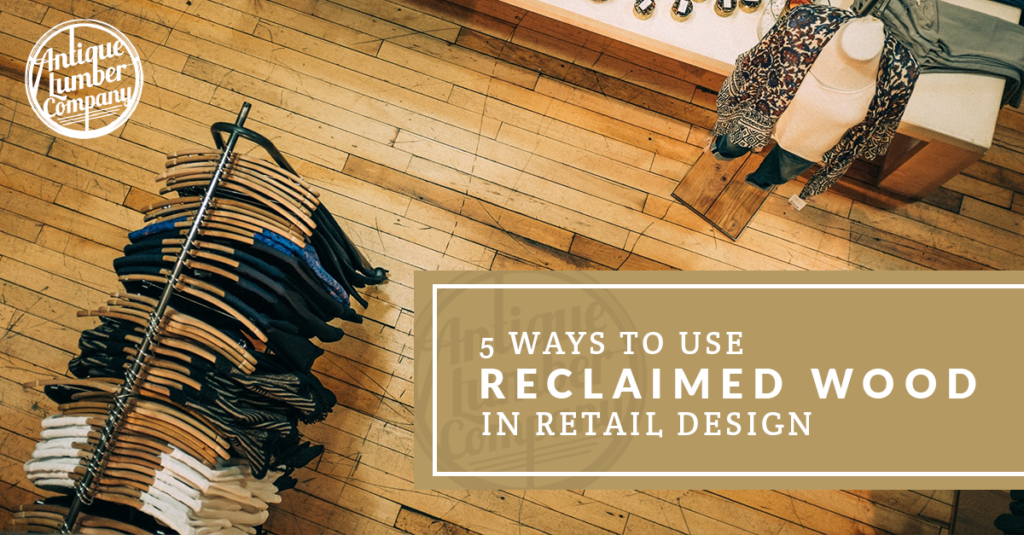
Do you own your own retail business? If so, you probably already know how tricky it can be to design a store’s interior. Most people never really stop to think about it, but it often takes months of planning in order to create a unique space that customers will really love. What’s more, businesses still in the startup phase may not be able to hire an interior design firm to take care of this aspect of operations.
Although there are many “best practices” when it comes to retail design, a creative way to help your store’s interior stand apart from the rest is by using reclaimed materials to create a one-of-a-kind atmosphere. The use of reclaimed wood is a particularly popular trend due to its inherent versatility as both a reliable building material and as an attractive decorative element. Additionally, the use of reclaimed materials is an eco-friendly alternative to using newly manufactured and produced building materials.
Using Reclaimed Wood in Retail Design
Think you need to be running a “rustic” business in order to use reclaimed wood in your store’s design? Think again! One of the best things about reclaimed materials is that they work well in retail businesses situated in all sorts of niches.
If you’re thinking about jumping on the reclaimed wood design trend, below are some creative ways to use it in retail shops.
Storefront and Signage
They say first impressions are lasting impressions. It makes sense, then, that big-name brands and boutique shops alike love using reclaimed wood in their outer storefront designs.
Some well-known stores that commonly use wood in their storefronts include Anthropologie, Whole Foods, and West Elm. But smaller shops can benefit by using rustic wood in their storefront designs because unique looks tend to be more eye-catching. Unique storefronts also have a tendency to draw photo-savvy social media mavens. (Can you say free publicity?)
Below, the storefront at McBean’s in the United Kingdom is a beautiful example of a storefront with a reclaimed wood look. California’s Sweetgreen features a more modern spin on reclaimed wood design.
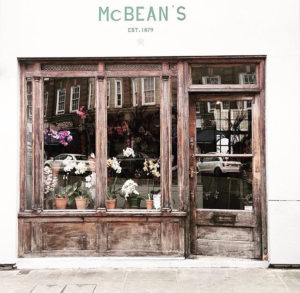 McBean’s Orchids – East Sussex, United Kingdom
McBean’s Orchids – East Sussex, United Kingdom
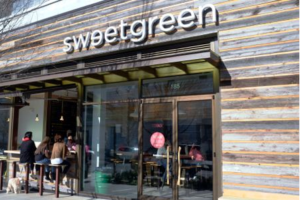 Sweetgreen – California
Sweetgreen – California
Displays
When your customers enter your store, the first display area they come across is known as the “threshold.” It’s crucial that this area makes an impact as soon as someone walks through the storefront. The second-most impactful area your customers will encounter is the area that sits to the right of the threshold. (The vast majority of customers who enter brick-and-mortar shops turn right after entering the store.)
Essentially, you’ll want to make certain that people who come across these areas experience a wow-factor when setting eyes upon the merchandise. And this includes display areas outside of those prime threshold areas, too. In order for this to happen, your displays should be well-designed and unique.
Oliver & Rust, a vintage shop in Ontario, does an amazing job of utilizing reclaimed wood and other reclaimed materials in their retail displays, as you can see below.
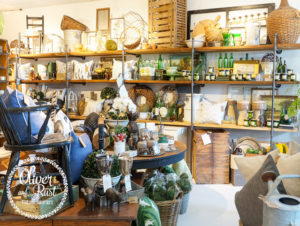 Oliver & Rust – Fonthill, Ontario
Oliver & Rust – Fonthill, Ontario
Flooring, Walls, and Ceilings
Of course, some of the most traditional uses for wood in commercial and private structures include flooring, walls, and even ceilings. Utilizing reclaimed wood on these surfaces helps to create an all-encompassing, 360° experience. If your business happens to be situated in a niche that is well-complemented by reused materials, using reclaimed wood brings out the store’s personality and serves as an extension of the brand.
Below, reclaimed wood walls and floors work well for Love and Whiskey in California, which is a retail clothing store featuring earth-toned clothing. Wood floors are a no-brainer for the garden supply shop Terrain as well.
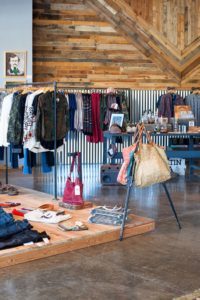 Love and Whiskey – Irvine, California
Love and Whiskey – Irvine, California
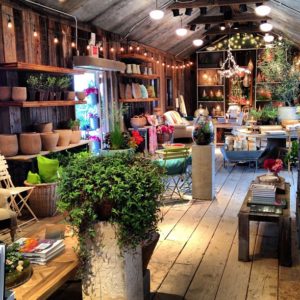 Terrain – Glenn Mills, Pennsylvania
Terrain – Glenn Mills, Pennsylvania
Sales Counters
Reclaimed wood can serve as both a design element and as a practical building material. One focal point of any retail space is the sales counter, so using wood to build a counter that serves its purpose and draws the eye is a great idea.
Melbourne-based home goods store Mynd Interiors uses reclaimed wood in their sales counter, which balances well with the bright colors and patterns featured in the items they sell. The sales counter at The Vintage Cottage in Oregon uses reclaimed wood to achieve a shabby chic effect.
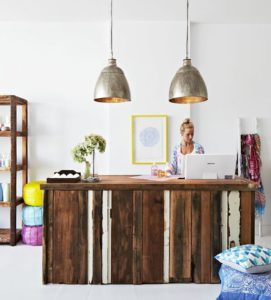 Mynd Interiors – Melbourne, Australia
Mynd Interiors – Melbourne, Australia
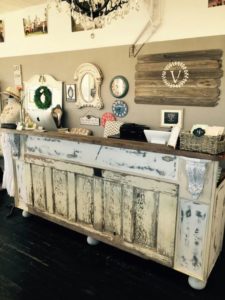 The Vintage Cottage – Prineville, Oregon
The Vintage Cottage – Prineville, Oregon
Lighting
Last but not least, another important aspect of retail design is lighting. Not only should you consider the type of lighting your space will use (warm, bright, dim, etc.), you should also consider the lighting fixtures themselves. The fixtures you select should be yet another continuation of the atmosphere you’re trying to create.
Options for wood lighting fixtures run the gamut, so incorporating your desired look shouldn’t be terribly difficult. From industrial to bohemian, wood lighting fixtures have become quite popular in both commercial and residential interior design. Some examples are pictured below.
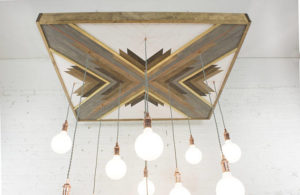 Geometric Wood Art Chandelier, by Hangout Lighting
Geometric Wood Art Chandelier, by Hangout Lighting
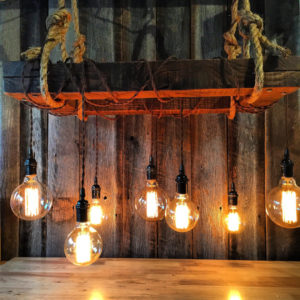 The Abraham Chandelier, by Rustic Design Company
The Abraham Chandelier, by Rustic Design Company
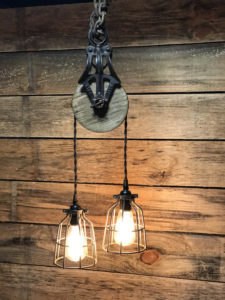 Barn Pulley Pendant, by Rustic Design Company
Barn Pulley Pendant, by Rustic Design Company
Ready to add reclaimed wood to your retail design?
As you can see, there are endless possibilities when it comes to incorporating reclaimed wood in retail spaces. All you need is the wood itself.
Antique Lumber Company is located in Gainesville, Texas. We take great care in gently reclaiming the finest antique longleaf pine we can find, and we source all our materials from century-old structures like homes, barns, and warehouses throughout the North Texas region. The lumber, doors, windows, and hardware we salvage find new life in retail spaces, restaurant interiors, homes, and much more.
We’re proud to contribute to the reforestation of longleaf pine forests by keeping this incredible lumber out of the landfills.
Please visit us at our warehouse or read more about us here to read why we believe longleaf pine is exceptional as a building and design material above all others.



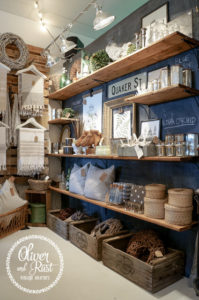
beaty construction
27.02.2018 at 16:04Thanks for writing this awesome article. I’m a long time reader but I’ve never been compelled to
leave a comment.
Nigel William
30.03.2018 at 15:52Do you have an article regarding those wood finishes? What kind of wood finish would be good for a storefront?
Erin Williams
22.08.2018 at 14:09Hi Nigel, that’s a great question and one that we will certainly look into exploring in a future blog conversation. Stay tuned!